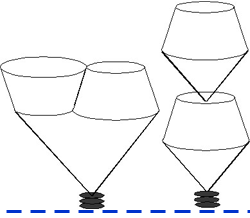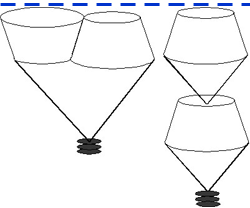|
Designing Your Parachute Lesson
In designing your parachute lesson plan, your probably
won't get very far without doing the activity
yourself. Just as students need to become familiar
with the materials they are designing with or the product
they are redesigning you'll need hands-on experience
with model parachutes before designing your lessons.
The Learning By Design™ curriculum breaks up
the activity into a Messing
About phase, where students explore materials and
see how model chutes work, an experimental phase where
they control key Parachute
Variables and note the effects off changing them
while producing Design
Rules-of-Thumb, and then doing final testing and
reporting findings. As you can read in DITC, students
can easily fall prey to many general Ways
of Naive Designers. They also can focus too early
on the time it takes their parachutes to descend, and
pay scant if any attention to Key
Design Criteria. For each day in your activity,
you could attempt a Formative
Assessment approach and ask, "What easy-to-collect
data could inform my next day's teaching and let me
know what students learned?"
When it comes to assessing what students' understand
from using the parachute task, DITC references three
follow-up and related
Transfer Tasks. One is the MapleCopter Task (developed
by Michal Lomask and others at the Conn. Dept of Ed),
where students investigate the rate of descent of maple
seeds as they twirl to the ground. You can see the Paper Helicopter
task being done by science teacher, Earl Carlyon, and
a Design a Toy
activity that tech ed teacher, Ed Goldman, devised to
follow Parachute.
Depending on your subject, you can focus on ideas directly
relevant to your course. Here are some suggestions:
• IN MATH, a study of 2-D and 3-D geometric
shapes is helpful in understanding inflation and
in figuring out when the 15% limit on vent hole size
has been exceeded. Measurement and rounding
are important in making the chutes and calculating
rate of descent to determine their effectiveness.
Working with variables, critical to algebra-based
thinking, is done concretely with the parachute task.
• IN SCIENCE, an understanding of Newton's Laws
of Motion helps in analyzing and explaining the
terminal speed of the chute. Being able to design
experiments is central to students developing design
rules-of-thumb -- experiment-based hints to other
designers on how to deal with the parachute's many design
variables.
• IN TECHNOLOGY EDUCATION, there are issues of
understanding the design process, and the creation
and use of test-based design rules-of-thumb.
In addition, using good fabrication skills to
make a reliable and good-performing device could be
emphasized, as well as a systems thinking
perspective that saw the chute as a complete system
as well as a collection of components that can be analyzed
separately.
The following Parachute Questions can be used as pre-
and post-tests with students, along with others you
create:
1. What force pulls a parachute toward the ground? (circle)
- gravity
- inertia
- drag
- momentum
1b. What change in a parachute's design would increase the pull of gravity on it?
2. What force pushes upward on a parachute as it falls? (circle)
- gravity
- inertia
- drag
- momentum
2b. What change in a parachute's design would increase the upward force on it?
3. Describe two steps or design strategies that you did when designing your parachute, either by yourself or with your group?
4. Which parachute do you think will fall most slowly? Explain two reasons for your choice.
5. Which parachute do you think will fall more slowly,
Chute A or Chute B?
Read over each design rule-of-thumb? Circle YES
if it applies to the two parachutes above, and NO
if it does not.
a. The more canopy you use, the slower the descent. YES
NO
b. The heavier the parachute, the faster the descent.
YES NO
c. Vent holes make the parachute more stable when falling.
YES NO
6. If you had one more day to work on it, what would be your next model parachute design?
Sketch or draw it below, and give two reasons why you would make it that way.
| Draw and Describe |
Reasons |
7. Fair Test Here are two different ways to hold a pair of parachutes during a test drop. Method #1
has the bottoms of the weights even with one another. Method #2 has the tops of the canopies even.
Which test is more fair? Why?
| Testing Method #1 | | Testing Method #2 |
 | OR |  |
Which Test?
Reason:
|